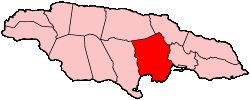
Population: 411,600 (1999)
Capital: Spanish Town
Major Towns: Old Harbour, Bog Walk, Linstead, Ewarton, Portmore

St. Catherine is the third largest parish in Jamaica, covering 1,192.4 square kilometers (460.4 square miles) in the southern part of the island. The parish features flat plains in the south, including the Hellshire Hills near the coast, and mountainous regions in the central and northern areas. Mount Diablo forms the northern border, with the highest point at 686 meters (2,700 feet).
The southern part of the Rio Cobre basin is a plain spanning approximately 57,000 acres. The Rio Cobre River runs through this plain, providing water for irrigation and hydroelectric power. The parish also contains significant wetlands, including the Hellshire/Cabaritta swamp, the Great Salt Pond, and the Hunts Bay Dawkins Pond.
Mineral deposits in St. Catherine include bauxite, copper, limestone, commercial marble, clay, sand, and gravel. The parish is also home to 44 caves, with St. Clair Cave near Polly Ground being one of the longest penetrable caves in Jamaica.
History
St. Catherine, established in 1534 and named after Queen Katherine of Portugal, was the site of the first Spanish settlement in Jamaica, initially at Seville and later moved to Santiago de la Vega (now Spanish Town). Sugar cultivation began early, and the area thrived under both Spanish and English rule. The English renamed the town Spanish Town, maintaining it as the administrative capital until 1872.
Spanish Town's Georgian Square, featuring the Rodney Memorial and the former House of Assembly, highlights the parish's rich cultural history. The town was a hub of activity with churches, synagogues, taverns, theatres, a slave market, and a prison. Over the years, the parish boundaries were redefined, incorporating areas such as St. Thomas in the Vale, St. John, and St. Dorothy.
Agriculture
Agriculture is a significant source of employment, with small farmers practicing mixed farming. Key crops include bananas, coconuts, pineapples, citrus, pumpkins, peppers, coffee, and callaloo. Larger estates focus on sugar cane, bananas, and citrus.
Dairy and Fish Farms
The parish hosts several dairy farms, including a model thousand-acre farm in Old Harbour. The Salt Ponds District is renowned for its fine fish, especially from Hanson and Dawkins Salt Ponds.
Industries
St. Catherine is a major industrial center, second only to Kingston and St. Andrew. Alcan's plant in Ewarton, the largest salt plant in the Caribbean in Spanish Town, and various industrial estates contribute significantly to the parish's economy. St. Catherine is also home to two of the eight remaining sugar factories in Jamaica, Bernard Lodge, and Worthy Park.
Colbeck Castle
Located 2.4 kilometers northwest of Old Harbour, this ruin is believed to have been built by John Colbeck, a member of the army of Penn and Venables in 1655.
Old Iron Bridge
Built in 1801, this is one of the oldest surviving iron bridges in the Western Hemisphere. It stands on a cut stone foundation dating back to 1675.
Mountain River Cave
Located near Guanaboa Vale, this cave features approximately 200 Arawak petroglyphs dating back 1,300 years.
Rio Cobre River and Gorge
The Rio Cobre River is one of Jamaica's largest rivers, providing irrigation for 18,000 acres of plains. The river gorge is notable for its dramatic sides, reaching 700 feet in some places.
Emancipation Square
Formerly known as Spanish Town Square, Emancipation Square features Georgian architecture, including Kings House, the House of Assembly, and the Rodney Memorial.
St. James Cathedral
This Anglican Cathedral, also known as the Parish Church for St. Catherine, stands on the site of one of the first Spanish churches in the Americas.
White Marl Arawak Museum
This museum, shaped like an Arawak hut, is located on the site of an Arawak village and displays artifacts that showcase the Arawaks' contributions to Jamaican culture.